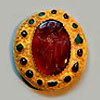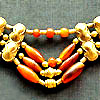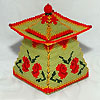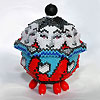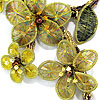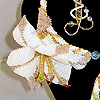July, 2009

Enjoy your summer!Feel the hot sun turning your skin red, hear the insects fill the night with noise, smell the rain of a summer storm, relive summer family vacations! In the current issue:
Carnelian in human history
Contact us with any questions at
info@mylovelybeads.com.
Colorworks Challenge Featured artist - Agnes Nyisztor Incorporating art Ganutell, wire and beads Step by step - bead chains August upcoming events Best regards,
MyLovelyBeads.com Team |
Carnelian in human historyOne of the July stones is carnelian. It has long held a presence in world history and the beliefs and customs of ancient civilizations. From Europe, to Asia, to the Middle East, archaeologists have found examples of carnelian use. Carnelian was recovered from Bronze Age Minoan layers at Knossos on Crete in a form that demonstrated its use in decorative arts; this use dates to approximately 1800 BC. Ancient Greeks and Romans called it Sardius and used the stone for cameos and intaglios. Carnelian was used widely during Roman times 2000 years before the present era to make signet or seal rings for imprinting a seal with wax on correspondence or other important documents (hot wax does not stick to carnelian). Sard (the brownish red variety of carnelian) was used for Assyrian cylinder seals, Egyptian and Phoenician scarabs, and early Greek and Etruscan gems. In more modern times, Goethe attributed the powers of protection against evil, of continuation of hope and comfort, and of good luck. The greatest myths surrounding the stone carnelian, come from the Egyptian Culture. The Egyptian goddess Isis protected the dead with a carnelian amulet named Thet. After being soaked in Ankhami flower water, on a Sycamore plinth (a type of tile) and placed on the body of the deceased, Isis would grant the person protection from harm while moving through the afterlife. The stone also appears In Hebrew Mythology; Aaron's breastplate included a carnelian stone. Buddhists in China and India created amulets inlaid with carnelian and other semi-precious stones, ascribing to them powers of protection and utilizing them for many rituals. In India, Hindu astrology names carnelian as the secondary stone of Scorpios. |
|
Colorworks ChallengeThe first Colorworks Challenge was held by Step by Step Beads Magazine. The orange-purple-green tertiary triad presents a challenge of bold and striking contrasts, and contest participants had to create a piece of bead jewelry with the predominant colors of that triad (any shades of those colors). Finalists were selected by Margie Deeb, Colorworks author, and the editors by Step by Step Beads. The first place winner is Cheri Stewart - who will receive a copy of Margie Deeb's book for her To Bead necklace. Her winning piece will be showcased along with the following other 9 finalists as the top ten entries to our contest, in a special Colorworks gallery in the November/December issue by Step by Step Beads:
• Lindly Haunani, Translucent Lei
• Maureen Thomas, Circles & Squares • Gretchen Coats, Floral Vibrance • Carol Simmons, Jeweled Bead Necklace • Maron Mehnert, Tribal Unity • Pippit Carlington, Peace, Love and All That Jazz • Zoya Gutina, Lush Spring Blues • Dawn O'Bryan-Lamb, Venus and Neptune • Mikki Ferrugiaro, Watermelon and Peaches Our warmest congratulations to all Colorworks Challenge finalists! |
|
Featured artist
Agnes Nyisztor lives in Hungary, in a small town called Bekescsaba. She started working with beads about five years ago, when she made a few critters for her granddaughter. Soon Agnes created several simple necklaces and bracelets, and she noticed that she fell in love with beadwork! As time has passed, she gotten involved more and more and she started learning the beading techniques from newsletters, magazines and books. Agnes went along step by step, it was not an easy process, sometimes she struggled, but never gave up! She was getting more captured by the world of beads and became interested in all the great opportunities beading offers. With the help of the Internet, a whole world of beading has opened up to her. She was enchanted by the beadwork of world known jewelers and she thought that she would never be able to make the wonderful things they do. Agnes got so much help from senior jewelry makers and she wants to take the opportunity now to thank all of them for that. Now, basically, she has got no day without beads! Agnes says, "I like using all techniques I have learned, but my favorite is the peyote stitch. When I saw, on the website of Julia Pretls, the boxes made by this famous bead artist, I fell in love with them. It was love at first sight. My friend Eva Fisher presented me Julia's book called Little Bead Boxes, and this book meant a lot to me. I was able to learn special techniques and how to make beaded boxes. I made nearly all the boxes from the book, while designing my own new ones. In total, I have created 24 beaded boxes using a huge amount of Delica beads!"
Full article by Agnes Nyisztor
|
|
Incorporating artIncorporating Art is the short story on the necklace recently created by Zoya Gutina. She says, "At the end of June surfing Artbeads.com I found out there very interesting pieces - pendants replicated portions of famous paintings from artists such as Chagall, Mucha, Klimt, Botticelli, Matisse and Picasso, handpainted by Russian artisans. These Russian pendants feature just a small piece of the whole paintings, but in doing so, the essence of the artistry is captured! I fell in love with one of them featuring The Dream by Picasso, that reminded me of the traditional Russian folk art - Palekh lacquer miniatures, and decided to take it. The backing of the pendant was a piece of black onyx, and the pendant was drilled from top to bottom. It's great for a wide range of stringing opportunities but not for beadweaving. Nevertheless, I found how I could incorporate that piece of art into my beadwoven necklace! It was a pleasure to play with colors and texture. I decided not to round angles on the netting base of my necklace, because the pendant is rectangular and I wanted to keep the common shapes. I've tried to use the same colors as on the miniature, but without big bright spots, just to accent the beauty of the pendant. Now Picasso's Dream Necklace is done. I hope you will like my new beadwork!" If you have a story on a jewelry piece making you want to tell the others, send us your story with a photo, and we'll publish it! |
|
Ganutell, wire and beads
Marina Somova, who lives in Leningrad (now St. Petersburg), believes that her jewelry comes from her soul and keeps the warmth of her hands. It is her goal to bring joy and happiness to people through her jewelry. This goal began 13 years ago when her friend showed Marina the beadwork she had done; Marina was astounded that the adornments were made by her friend and thought she would never be able to create anything as wonderful. Her friend then taught Marina to do beading and mentored her as she learned. Right from the beginning Marina said she would only create art that she liked and nothing designed by others - she still does not do custom work keeping all of her jewelry to things that she likes. As Marina learned to work with beads she also was knitting, cross-stitching and doing other crafts. Though her dream all along was to become a jewelry designer and she felt that beads were the best media to make her dream come true. Due to illness, Marina has to spend much of her time at home and says that beadwork has saved her life. She has used the Internet to discover the work of artists around the world. When Marina discovered ganutell, a Maltese art form of making artificial flowers from wire, thread, and beads, she was in awe of the beauty of ganutell flowers. She then had the idea to make the flowers smaller and incorporate them into one of her jewelry pieces. She was very happy with her creation as were her friends, which was a great impression for her. Since ganutell, which is now a distinctively Maltese art form, was something she wanted to do more of Marina learned bead wirework since they are closely related. Now, Marina, who is proud that she lives in one of the most beautiful cities in the world, is a universal artist working with different media. Everywhere her jewelry is seen it brings in success for her. When she first started designing jewelry Marina just wanted to get some skills and now she focuses on making pieces that will be liked by others. Though she will not make replicas of her pieces; they will all remain unique to this artist.
Ganutell, wire and bead jewelry by Marina Somova
|
|
Step by step - bead chains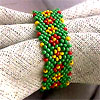
Three more small tutorials for beginners by Victoria Katamashvili. Today you can learn chain stitches, that can be applied when making beaded jewelry and any bead decorations. We believe, they will be useful for those who wants to start beading and not only for them. Have fun! If you got stuck, you may ask Victoria any questions at master-raduga@yandex.ru. |
|
Upcoming events
Expo: August 19 - 23, 2009 The 8th annual Bead Fest Philadelphia festival is the largest bead & jewelry show on the East Coast. Special events include: Meet the Instructors Reception - come and meet the world famous instructors, see what they are teaching and sign up for workshops. There will be also Moonlight Bead In event - you can bring a project you are currently working on and get a chance to mingle with fellow beaders, Interweave Editors and Bead Fest staff! |
|
Note
If you don't see the newsletter properly formatted please click here:
July Issue
|
© 2010 MyLovelyBeads.com All Rights Reserved.
If you do not want receive our newsletter and you wish to remove your email address from our mailing list, please click the following link to unsubscribe.



